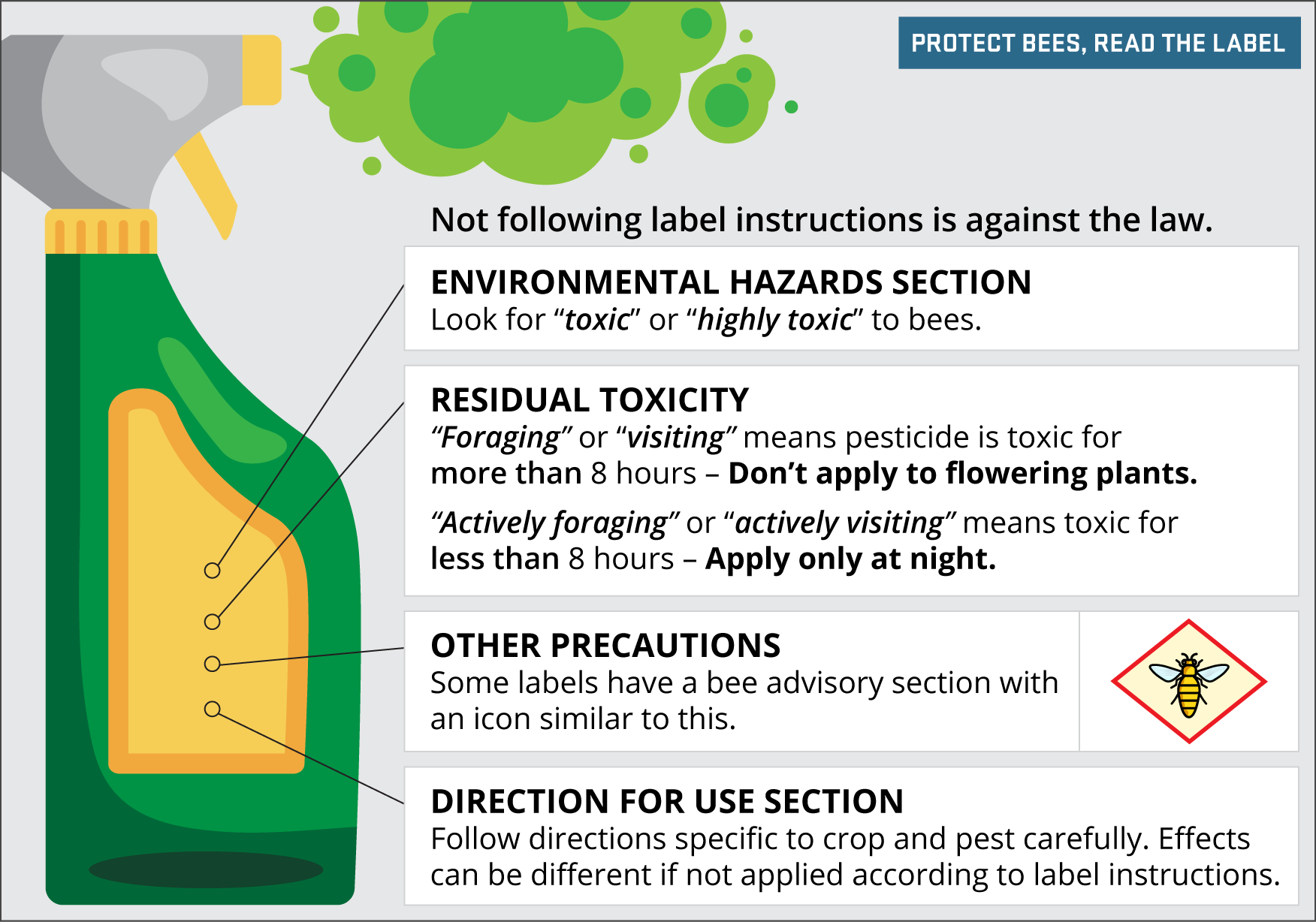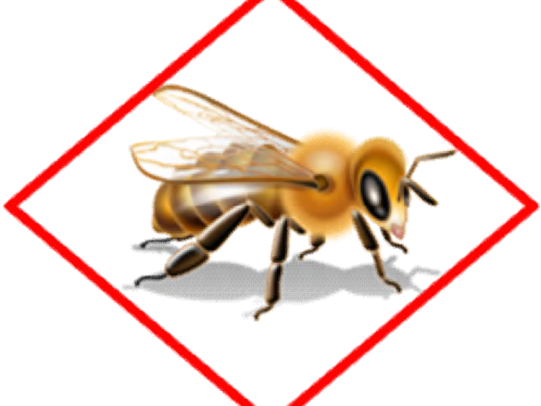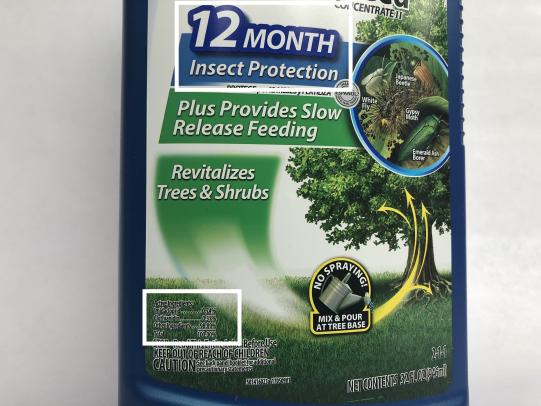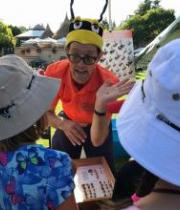Understanding pesticide labels to protect pollinators
The photo shows a butterfly on a flower. Along with bees, butterflies and moths are often pollinators.
What are pollinators?
- Pollinators include honey bees, native bees, butterflies, and even hummingbirds. They all are attracted to plants’ flowers. Flowers provide food resources for pollinators, including nectar for energy and pollen for nutrients.
- As pollinators visit each flower, they collect pollen on their body. Then they transfer the pollen to the next flower. This pollen transfer assists sexual reproduction in plants to form fruits or seeds.
What are pesticides?
Pesticides are products designed to kill rodents, weeds, mosses, insects, plant diseases, slugs, and snails.
JUMP TO
- How to Find Information about Pollinators on Insecticide Labels
- What the Label Says and What That Means for Pollinators
FOR QUESTIONS ABOUT PESTICIDES
The National Pesticide Information Center (NPIC) can answer questions about pest control chemicals.
1-800-858-7378 or npic@ace.orst.edu"
Tilia / linden / basswood tree Information
It is illegal in Oregon to apply certain neonicotinoid insecticides on linden trees, basswood trees, or other Tilia species.
See Oregon Department of Agriculture’s 2015 PESTICIDE ADVISORY Bees and Linden Trees (PDF).
Neonicotinoids include active ingredients such as dinotefuran, clothianidin, imidacloprid, and thiamethoxam.
- These products are absorbed by one plant part (e.g., stems or roots) and move to leaves or other plant parts.
- Following application, the poison may be found in flowers for months or years.
- Beneficial insects feed on the nectar and pollen.
Tilia species’ flowers are very attractive to bees.
Apply this same reasoning to other bee-attractive shade trees and woody ornamental shrubs.
If you suspect a pesticide incident with bees, call the Oregon Department of Agriculture at
503-986-4635.
Overview
- Insecticides are pesticides designed to kill insects. Most insecticides can be harmful to pollinating insects, including bees and butterflies. However, some are more harmful than others. Read the ENVIRONMENTAL HAZARDS section of the product label. See below for more details.
- Herbicides (chemical weed killers) sprayed on flowering weeds can harm pollinators. Manage weeds before they flower. If possible, make chemical applications in the morning or evening when bees are less active. Avoid spraying flowers and pollinators directly.
- Even fungicides can be harmful to pollinators. Research has shown that honey bees exposed to certain fungicides are more susceptible to parasites and disease.
- Pesticides are listed as a contributing factor to colony losses. Other suspected causes include: parasites, disease, poor nutrition, lack of genetic diversity in bees, and habitat loss.
Keys for Success
- Read pesticides labels. Follow the instructions.
- Use information provided on pesticide labels to understand the risks of a product.
- Labels also tell you how to apply pesticide products correctly.
- Look for information about hazards to pollinators in the ENVIRONMENTAL HAZARDS section of the pesticide label.
- Follow the instructions to minimize risks.
- Follow the instructions to maximize benefits.
Why are pesticide labels essential to read?
- Labels are legal documents. Failure to follow the instructions is against the law.
- The label will indicate if a pesticide is toxic to bees. The information is, however, not easy to find and understand.
- The following stems guide you where to find and how to understand crucial information to protect bees.
Look in the ENVIRONMENTAL HAZARDS section of the pesticide label
- If the symbol below (bee inside red diamond) appears on a pesticide product label, it means the product contains an insecticide in the neonicotinoid family. These insecticides are referred to as “neonics.”
- The products are highly toxic to bees at low levels. Even the residue can be harmful for a long time. Don’t use these products around plants that are attractive to bees.
Neonicotinoid insecticides can harm pollinators and natural enemies
- Following application, poisons may be found in flowers for months later, particularly in wood ornamental plants.
- Beneficial insects feed on the nectar and pollen. See OSU’s How to Reduce Bee Poisoning from Pesticides For more information for more information.
How to read pesticide labels to learn about pollinators
Open the label on the back and read the instructions carefully.
-
Look for information about hazards to pollinators in the ENVIRONMENTAL HAZARDS section of the pesticide label.
-
See the graphic below for details about what to look for on the label.

- PROTECT BEES BY READING THE LABEL — Failure to follow label instructions is against the law.
- ENVIRONMENTAL HAZARDS SECTION — Look for “toxic” or “highly toxic” to bees. RESIDUAL TOXICITY. “Foraging” or “visiting” means pesticide is toxic for more than 8 hours. Apply only at night. Labels might also say “This product is highly toxic to bees exposed to direct treatment or residues on blooming crops or weeds. Do not apply this product or allow it to drift to blooming crops if bees are actively foraging the treatment area.”
- OTHER PRECAUTIONS — Some labels have a bee advisory section with an icon of a bee inside a red triangle (as shown above).
- DIRECTIONS FOR USE SECTION — Follow the directions specific to crop and pest carefully. Effects can be different if not applied according to the label instructions.
- Do you want to interpret language that you see on a pesticide label?
- Look for information about hazards to pollinators in the ENVIRONMENTAL HAZARDS section of the pesticide label.
- Learn what the information about pollinators on pesticide labels means.
What the Label Says: “This product is highly toxic to bees and other pollinating insects exposed to direct treatment or residues.... Do not apply this product or allow it to drift to blooming crops or weeds if bees or other pollinating insects are visiting the treatment area.”
What That Means: This means the product contains an active ingredient that kills 50% of bees exposed to 2 micrograms or less. That’s highly toxic! It also means this product has “extended residual toxicity.” The residue is likely to be harmful to visiting pollinators, even several hours or days after the application. Even night-time applications would be a high-risk action for pollinators.
What the Label Says: “This product is moderately toxic to bees and other pollinating insects exposed to direct treatment or residues on blooming crops or weeds. Do not apply this product if bees or other pollinating insects are visiting the treatment area.”
What That Means: This means the product contains an active ingredient that kills 50% of bees exposed to 11 micrograms or less. It also means this product has “extended residual toxicity.” The residue is likely to be harmful to visiting pollinators, even several hours or days after the application. Even night-time applications would be a high-risk action for pollinators.
What the Label Says: “This product is toxic to bees and other pollinating insects exposed to direct treatment. Do not apply this product if bees or other pollinating insects are actively visiting the treatment area.”
What That Means: This means the product contains an active ingredient that kills 50% of bees exposed to 11 micrograms or less. It also means this product does NOT have “extended residual toxicity.” The residue is not as likely to be harmful after several hours. A night-time application, if absolutely necessary, could be low-risk for pollinators.
What if there is no mention of pollinators? That doesn’t mean zero risk to pollinators.
If there is no mention of pollinators in the ENVIRONMENTAL HAZARDS section of the label, it means that low doses (11 micrograms or less) were not sufficient to kill many bees during tests. Lower exposure leads to lower risk. If possible, avoid using insecticides and fungicides during peak pollinator activity.
Content provided by Kaci Buhl and Weston Miller. Content reviewed by Andony Melathopoulos.
Peer reviewed by OSU Department of Horticulture.
PESTICIDES & POLLINATORS REFERENCES
How to Reduce Bee Poisoning from Pesticides
PNW Insect Management Handbook
Bee and Pollinator Health Publications
Oregon State University
Resources for Pesticide Applicators
Oregon Bee Project
Resources for Landscapers
Oregon Bee Project
Resources for Gardeners
Oregon Bee Project
Pollinator Conservation Resources: Pacific Northwest Region
Xerces Society
Recursos en Español
Oregon Bee Project




